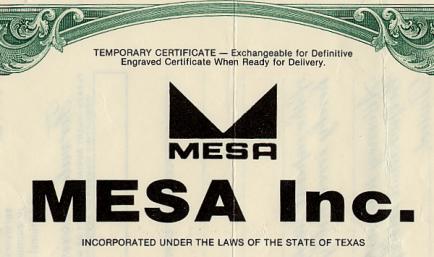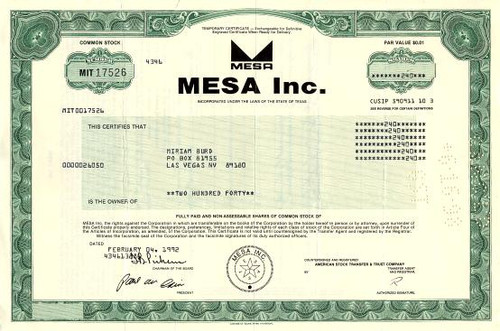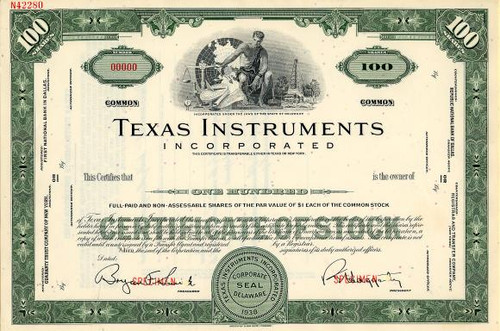Beautifully engraved certificate from Mesa Inc issued in 1992. This historic document was printed by the American Banknote Company and has an ornate border around it with a vignette of men in an oil field. This item has the printed signatures of the Company's President and Chairman of the Board (T. Boone Pickens). Light folds from original mailing. 
Certificate Vignette Mesa Petroleum, also known as Mesa, Inc., the nation's largest independent producer of domestic oil and gas and one of its largest gas producers, is a publicly held corporation with headquarters in Dallas and offices in Amarillo, Fort Worth, and Las Colinas. (Independent operators are distinguished from major oil companies primarily by their smaller size and lack of vertical integration.) It was founded by Thomas Boone Pickens, the son of a landman, a person whose job is to find landowners willing to lease mineral rights and then sell their leases to oil companies. Pickens was born on May 22, 1928, in Holdenville, Oklahoma, moved to Amarillo while in high school, attended Texas A&M for a year, and received his geology degree from Oklahoma A&M in 1951. After working as a roughneck and in a refinery, he became a geologist for Phillips Petroleum, but difficulties in dealing with company bureaucracy forced him to resign in 1954 and start out on his own. For two years Pickens was self-employed in well-site and consulting work. He founded the company that became Mesa Petroleum in 1956, when he entered into a partnership known as Petroleum Exploration, Incorporated, with Eugene McCartt and John O'Brien, his wife's uncle. McCartt and O'Brien owned quarter interests and supplied a line of credit that enabled work on bigger ventures, while Pickens owned the remaining half and served as president. In its early deals, PEI made money by selling prospects it had discovered and retaining a "back-in interest" or percentage of the profits made by the well in its first few years. Eventually, the firm attracted a group of Amarillo investors who allowed it to drill its own wells, and in 1958 PEI discovered eight gas and one oil well in sixteen tries. In 1959, with the help of PEI investors, Pickens formed Altair Oil and Gas Company to explore for oil in Canada, once again serving as president and major stockholder. In 1960 the company acquired a Utah mining company, Standard Gilsonite, and in 1962 PEI drilled ninety-eight successful wells and made more than $750,000 in profits. Company employees increased from two to twenty-three, and investors to nearly 300. In 1963, when McCartt wished to sell his share in the company, Pickens and PEI lacked sufficient money to buy him out. PEI signed a three year note with McCartt to pay him for his interest in the company. McCartt threatened to take over the company when it almost defaulted on its payments, a situation avoided in 1964 when Pickens led the company in an initial public offering to raise capital. At the same time, Pickens renamed the company Mesa Petroleum for "the picturesque, table-topped lands that rise out of the Texas Panhandle." In this process, Mesa combined the properties of Altair and PEI, and acquired 239 stockholders from the two original firms. In its first year, Mesa produced revenues of $1.5 million and a net income of $435,310. The company grew steadily, and by 1968 had revenues of $6.2 million, profits of $1.4 million, and stock traded on the American Stock Exchange. Mesa's fame initially developed from its acquisitions. In early 1968, Pickens targeted the Hugoton Production Company of Garden City, Kansas, for a possible merger. Hugoton owned a substantial portion of the Hugoton gas field in southwestern Kansas, then the nation's largest gas field. When the Hugoton management rebuffed Pickens's offer, Mesa introduced a hostile tender offer that would give Hugoton shareholders 1.8 shares of Mesa's common stock for every share of Hugoton's. Because Pickens was not yet forty years old and his company was the smaller of the two, Hugoton's management and board of directors failed to take him seriously. In 1969, however, Mesa acquired nearly one-third of Hugoton's shares, and in April stockholders of both companies approved the merger. Hugoton assets gave Mesa the leverage it needed to expand its business and complete bigger deals. Shortly after completing the Hugoton deal, Pickens diversified with the purchase of the Swisher County Cattle Company and the Harmon and Toles Grain Company, a cattle-feeding operation in Hutchinson County, Texas. He also acquired Randall County Feed Yard, and began to increase the capacity in its yards. Within three years, Mesa was the second largest cattle feeder in the country, with the capacity to feed more than 160,000 cattle. By 1973 the firm also owned more than 150,000 head of cattle. Cash flow from cattle operations enabled Mesa get into offshore exploration, but the cattle industry experienced a downturn in 1973. Despite Pickens's efforts to hedge his cattle, the diversification effort ultimately failed and Mesa sold its cattle operations at a substantial loss. Mesa's next attempt at diversification linked it with a company closer to its line of business and with sizable oilfield reserves. Its offer to Southland Royalty Company of Fort Worth was terminated after the Southland management waged a successful legal battle against Mesa. In 1970, Mesa acquired Pubco Petroleum, based in Albuquerque, New Mexico, as well as undeveloped acreage and personnel that produced an aggressive rate of growth. In 1972 Mesa reported $92 million in revenues, $15 million in profits, and $189 million in assets. In 1976 the company discovered the largest field in its history in the North Sea. The Beatrice Field, named for Pickens's wife, netted the company a $31.2 million profit before Mesa sold it to the British National Oil Company, established by the British Labor Party. Faced with government requirements that BNOC participate in local finds made by non-British exploration companies, Mesa decided it was easier to sell than have BNOC as an unwelcome partner. Between 1973 and 1981, Mesa grew into one of the largest independent oil companies in the world, with assets of more than $2 billion. In 1980 reserves totaled more than twenty-five million barrels of oil and natural gas liquids and, by the end of the decade, almost 2.5 trillion cubic feet of gas. In 1979, facing a new Canadian tax policy, Pickens sold Altair Oil and Gas and founded the Mesa Royalty Trust to restructure the firm by spinning off a large portion of its reserves to shareholders. Mesa distributed trust units on the New York Stock Exchange equal to the number of shares each stockholder had in Mesa common stock. Stockholders received 90 percent of the profits from assets directly, while Mesa retained a working interest to manage the properties. In 1984 the Tax Reform Act dissolved such trusts. Pickens also succeeded in oil futures, but it was his repeated attempts to take over companies much larger than his own that led to his and the company's greatest fame. By the 1980s he came to believe that acquiring other companies had become more profitable than oil exploration and production. His skill lay in an ability to identify undervalued companies and make a profit when outside parties and the markets recognized their value. In the spring of 1982, Mesa made an offer for Cities Service Company of Tulsa, Oklahoma, a company more than twenty times the size of Mesa. Cities Service responded to Mesa's tender offer with a tender offer of its own for Mesa. Cities Service enlisted Gulf Oil as a "white knight," a company agreeable to management that could defend the targeted company, to help in their defense. Mesa eventually lost the battle, but sold the stock it owned in Cities Service back to the company for a $30 million profit. In the 1980s, Mesa attempted several other takeovers. It was outbid by Phillips Petroleum in a 1983 offer for General American Oil, a Dallas independent, but succeeded in acquiring a 5 percent portion of shares outstanding in Gulf Oil, the sixth largest oil company in the United States. Later that summer Pickens and a group of investors acquired additional stock to bring Mesa's total interest to 11 percent. Pickens then launched a proxy fight with Gulf for control of a company he viewed as poorly managed. Gulf's management offered Pickens a "greenmail" premium, an amount paid by a target company to repurchase its stock from a corporate raider, but he refused. Eventually, Socal Oil merged with Gulf in the largest merger in corporate history to date, and Pickens and his investors profited $760 million before taxes by tendering their shares to Socal. Mesa also attempted to buy Phillips Petroleum and Unocal, but did not acquire either. In late 1985, after a friendly merger with Pioneer, a large Amarillo independent oil and gas company, Pickens reorganized his company as the Mesa Limited Partnership, then the largest independent oil company in the world. The same year, he founded the Boone Company, a joint venture between Drew Craig, Sidney Tassin, David Batchelder, and Pickens, to deal separately from the Mesa Limited Partnership. In the late 1980s and early 1990s, Pickens attempted takeovers of Newmont Mining, a New York-based firm, Diamond Shamrock, and Koito Mfg., Ltd., a Japanese auto-parts manufacturer, making substantial gains in the process. After a dispute with the Amarillo City Council, Mesa moved its headquarters from Amarillo to Dallas in 1989, and in 1991 restructured itself from a limited partnership to a corporation. In that year the company also sold significant assets to Seagull Energy of Houston. Mesa employed approximately 300 people in 1993. T. Boone Pickens has been at the center of controversies surrounding Mesa. Called an "entrepreneurial populist," a corporate raider, and a greenmailer, he is accused of buying and breaking up companies and putting people out of jobs. In 1986 he started and funded a nonprofit organization called the United Shareholders Association to fund a newspaper informing shareholders of corporate abuses, and in 1987 he defended his position in a best-selling book entitled Boone. Pickens, for whom the West Texas A&M University business school is named, has served as the university's chairman of the board and supported other Texas universities. BIBLIOGRAPHY: T. Boone Pickens, Boone (Boston: Houghton Mifflin, 1987). Vertical Files, Barker Texas History Center, University of Texas at Austin (Mesa Petroleum, T. Boone Pickens). Keli Flynn "MESA PETROLEUM CORPORATION." The Handbook of Texas Online. [Accessed Thu Mar 21 7:50:15 US/Central 2002 ]. Mesa Petroleum Inc., founded in 1964 by former Phillips Petroleum geologist T. Boone Pickens, garnered most of that attention. By the early 1980s, the company ranked as the top natural gas producer in the U.S. It quickly expanded into offshore exploration and acquired foreign drilling rights. When oil and natural gas prices plateaued and drilling prospects became expensive to find in the field, Pickens set out to acquire a cheaper source of natural gas and oil other companies whose stocks were undervalued on Wall Street. Pickens moves on such companies as Occidental Petroleum Co. and Phillips made him a darling on Wall Street, which loved his calls for top management to take care of shareholder interests rather than concentrating on management perks. The bloom on Pickens' rose faded though with the bust at the end of the 1980s. The price of natural gas faltered and left the company with a pile of debt that led it to merge in 1997 with Parker & Parsley Petroleum Co. to form Pioneer Natural Resources Co., operator today of the Fain gas plant north of Amarillo that still supplies the city with natural gas. Pioneer Natural Resources is one of the top ten U.S. independent exploration and production companies. Pioneer's core properties stand out as some of the best in the industry. Since 1997, Pioneer has been busy building an exceptional exploration program while continuing its track record of development success. Recent discoveries in the deepwater Gulf of Mexico and South Africa are expected to add significant new production in 2002 and 2003. The 2001 exploration program will test 26 prospects generated over the past three years, a milestone for exploratory drillbit activity. Pioneer's long-lived assets provide a stable production base. Its extensive inventory of development drilling locations together with its active rig program in the U.S., Argentina and Canada provide lower-risk opportunity to continually add new production With total proved reserves equivalent to 3.8 trillion cubic feet of natural gas or 628 million barrels of oil and with a reserves-to-production ratio of 14 years, Pioneer's production is among the industry's most stable. Contributing to this stability, Pioneer's three domestic core properties - the Hugoton and West Panhandle gas fields and the Spraberry oil and natural gas field - represent 67% of the Company's total reserve base.

Certificate Vignette








